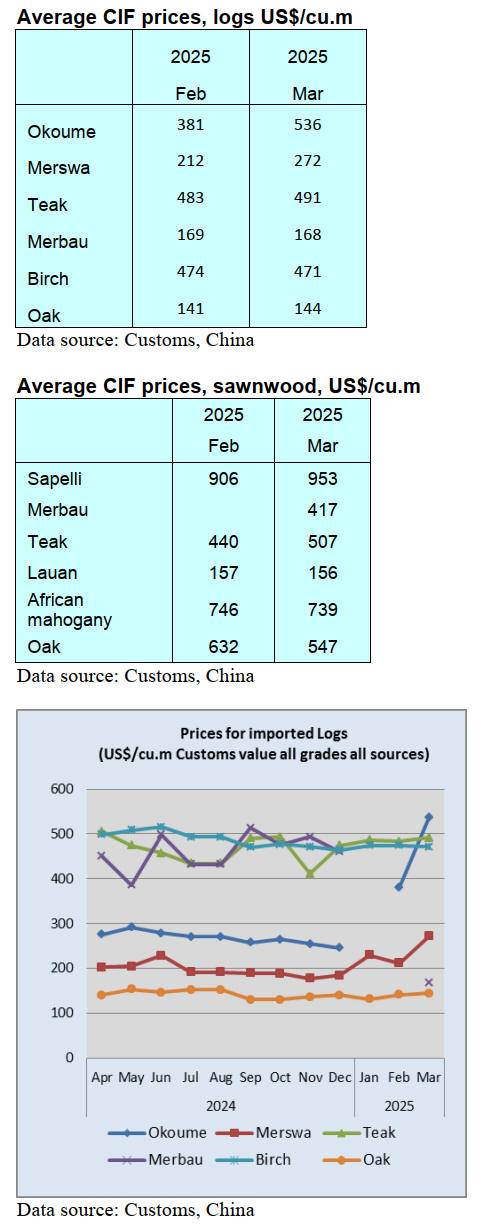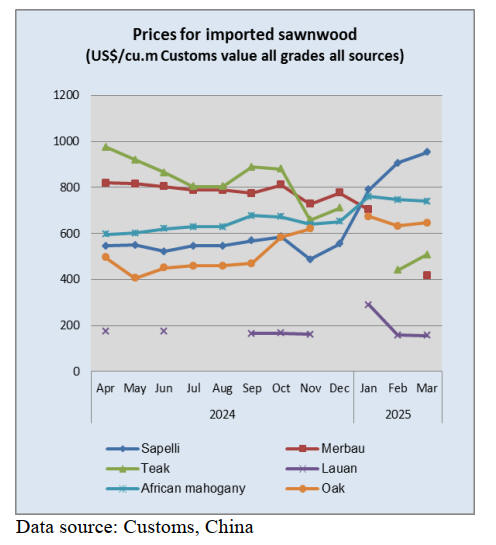US Dollar Exchange Rates of
25th
Apr
2025
China Yuan 7.29
Report from China
Subsidy rules for kitchens and bathroom renovations
The 2025 subsidy rules for home kitchens and bathroom
renovations have been released. The rules specify all
localities should focus on: green, smart and elderly-
friendly improvements, support individual consumers in
purchasing items and materials for renovation of old
houses, partial renovations of kitchens and bathrooms.
The subsidy includes five major categories, decoration
materials, sanitary ware, furniture and lighting, smart
home products and home elderly-friendly renovation
products. Each Province and City has been given the
authority to determine the specific categories based on
local industrial characteristics, household consumption
habits and the needs of the elderly.
The subsidy shall not exceed 15% of the actual purchase
price and 20% for products with energy efficiency or
water efficiency features and 30% for elderly-friendly
home renovation products. Each region can independently
determine the number of subsidised items per person and
per type of product, the maximum subsidy amount for a
single commodity or household and the cumulative
maximum subsidy per household.
The subsidy method should be based on Provincial
administrative divisions and in accordance with the
principle of territorial implementation.
The participants in the subsidy policy should be
determined in a fair and open manner and the subsidy
qualification should be determined in a transparent
manner.
Currently, subsidy implementation policies have been
released in cities such as Shandong, Sichuan and Shaanxi
Provinces.
See:
https://www.gov.cn/lianbo/bumen/202501/content_7001500.htm
and
http://www.linyi.gov.cn/info/2003/396002.htm
Global furniture supply chain facing shock
The recent announcement of reciprocal tariff policy by the
US will target several major sources of American furniture
imports and is expected to have a significant impact on the
global furniture supply chain.
Data shows that Viet Nam currently accounts for 37% of
the total furniture imports by the US and has been subject
to a 46% tariff, China faces a tariff rate of 34%. This,
combined with the existing 20% tariff rate, brings the
actual tariff rate on Chinese furniture to 54%. At present,
China and Viet Nam account for 60% of the total furniture
imports by the US.
In addition, other major furniture suppliers to the US, such
as Mexico, Canada, Italy, Malaysia, Indonesia and
Thailand have all been subject to double-digit tariffs rates.
The emerging supplier, Cambodia is facing a tariff rate of
49%, even higher than that of Viet Nam.
The tariff rates of EU countries including Poland, Italy,
Turkey and Portugal are 20%. However, considering the
high manufacturing costs of these countries, they will find
it difficult to gain any significant advantage from this tariff
adjustment.
As early as 2004, after the US imposed anti-dumping
duties on China’s bedroom furniture, Viet Nam began to
make its mark in the global furniture supply chain.
During the China-US trade friction in 2019 many furniture
manufacturers moved their production lines from China to
Viet Nam, enabling it to rise from second place to the top
exporter of US furniture. This tariff policy may change
this pattern again.
Regarding the policy's goal of bringing manufacturing
back to the US industry experts point out that labour
shortages are one of the main challenges, especially when
many industries affected by tariffs are seeking to localise
production and this issue may become even more
prominent.
This extensive tariff adjustment is expected to affect all
furniture imports entering the US and the global furniture
purchasing pattern may undergo fundamental changes as a
result.
Tariff impact on China's furniture industries
Some foreign furniture enterprises have introduced short
working time. For example Yihe Furniture located in
Huizhou, Guangdong Province issued a notice stating that
the introduction of the new US tariff policy has severely
impacted the company's business and closed operations for
a short time.
The unprecedented tariff barrier will not only reshape the
global furniture trade pattern but also push many furniture
exporters to the brink of collapse. The furniture industry is
one of the pillars of China's exports to the US and the
sector has relied on demand in the US market for a long
time.
According to customs data the total value of China's
furniture, bedding and lighting fixtures exports to the US
were approximately RMB224.7 billion in 2024. However,
the US tariff rate of 170% will eliminate the US market for
Chinese furniture.
Writers in China say what is more worrying is that the
effect of tariffs is destroying the profit margins of
enterprises. The furniture industry has always been
characterised by low profit margins but high sales
volumes. The net profit margins of most enterprises are
only between 5% and 10%.
The case of Yihe Furniture is not an isolated one. Since
the tariffs gradually rose in early 2025 more than 20% of
small and medium-sized furniture export enterprises have
been facing serious challenges.
The three main problems currently faced by China's
furniture industry are:
The tariffs rates will significantly reduce the
competitiveness of Chinese furniture in the US
market.
High tariffs rates have led to the cancellation or
postponement of some orders forcing enterprises to
confront a large amount of inventory overstock.
Overstocking undermines the cash flow of
enterprises.
The furniture industry has a long production cycle
due to tight capital chains. It usually takes 3 to 6
months from raw material procurement to finished
product shipment. Under the circumstances of
reduced orders and overstocked inventory, the
collection cycle of enterprises has been prolonged
and the risk of a broken capital chain has risen
sharply.
The impact of tariffs is not limited to export enterprises
but has also spread throughout the entire furniture industry
chain. Upstream and downstream enterprises such as raw
material suppliers, logistics companies and design
companies have also been deeply affected.
Under the name of "reciprocal tariffs", the US attempts
promote a revival of domestic manufacturing in the US.
Meanwhile, American consumers are bearing the cost of
the increased tariffs. Due to supply chain shifts and rising
production costs furniture prices in the US market have
generally increased, with the retail prices of some mid-to-
low-end furniture rising by more than 20%.
High tariffs rates may force China's furniture industry to
accelerate its transformation and upgrading in the long
term. Chinese furniture won by "low cost and high output"
in the past. However, against the background of the rise of
trade protectionism technological innovation, brand
building and market diversification will become the keys
for the furniture industry success.
Timber shipments via the China-Europe freight train
Since the first return trip of the China-Europe freight train
from Linyi to Moscow in March 2018 a total of 207
special timber trains have transported goods valued at
RMB730 million.
Linyi is known as the "Capital of China's Wood Panels".
Linyi is strategic node for the China-Europe freight trains
in Shandong Province and companies have utilised the rail
service to help Linyi build itself as a timber import
distribution centre and the largest international timber
trading market in Shandong Province. The policy of "one
declaration, one inspection and one release" for imported
goods has proven to raise competitivness.
Linyi has opened six China-Europe freight train lines,
providing a smooth logistics channel for importing wood
from Europe. To facilitate enterprises, enhance customs
clearance efficiency and reduce the accumulation of goods
at ports Customs has implemented a "two-stage access"
supervision system in Linyi city.
The first stage determines "whether the goods are allowed
to enter the country" at the port and the second stage
determines "whether the goods are allowed to enter the
domestic market for sale or use" at the final destination.
Under this pattern, imported goods can be released from
the port in advance and inspected at the destination which
helps solve the problem of high storage costs at the port.
Through the China-Europe freight train imported timber
has brought great business opportunities to enterprises in
Linyi City of Shandong province.
March GGSC report
In March China’s National Afforestation Commission
released a communique on China's land greening status in
2024 highlighting progress made over the past year. In
2024, China completed afforestation of 4.446 million
hectares with the forest coverage rate surpassing 25% and
the forest stock volume exceeding 20 billion cubic metres.
The latest data from the General Administration of
Customs indicated that the overall performance of China's
exports was positive in January and February this year.
Exports reached 3.88 trillion yuan, setting a new high for
the period and representing a 3.4% increase year-on-year.
However, the home furnishing and building materials
industry encountered a downturn during this period, with
the exports of furniture and parts (71.78 billion yuan)
seeing a decrease of 14.5%.
In March China's timber market demand began to enter its
traditional peak season. However, domestic port
inventories and import costs remained high, leading to
significant financial and inventory pressures for timber
traders.
Recently, the Chinese government announced efforts to
reverse the property market downturn and stabilise the
sector and to intensify the implementation of urban village
and old housing renovations.
In addition, in terms of urbanisation, efforts will be made
to include eligible rural migrants in the housing security
system. These measures are expected to enhance and
consolidate the demand for wood and wood products.
GTI-China index
In March 2025 the GTI-China index registered 58.1%, an
increase of 14.0 pentage points from the previous month
and was above the critical value (50%) after 4 months
indicating that the business prosperity of the timber
enterprises represented by the GTI-China index expanded
from the previous month.
With the arrival of the traditional peak season for China's
timber market all circulation links in its timber sector
showed upward trend and both production volume and
domestic new orders saw a significant increase in March.
As for the sub-indexes, all the twelve indexes were above
the critical value of 50%. Compared to the previous
month, the twelve indexes (production, new orders, export
orders, existing orders, inventory of finished products,
purchase quantity, purchase price, import, inventory of
main raw materials, employees, delivery time and market
expectation) increased.
See: https://www.itto-
ggsc.org/static/upload/file/20250418/1744957176173218.pdf


|